
Lab Reports Now Published Online
- Where to Find Lab Reports Online
- Cool Blue Light: The Making of Blue LEDs
- Great Kick-Off for Summer Lecture Series 2000
- Coming Up in the Lecture Series
- Lab Scientists Win Tech-Transfer Awards
- Berkeley Lab Currents
- Los Alamos Director Thanks Berkeley Lab Employees
- Washington Report
- Director Shank Takes Action to Increase Lab Diversity
- From Fisheries to the Farthest Reaches of Space
- Bulletin Board
- Calendar of Events
- Graduate Students, Postdocs Invited to NERSC Workshop on High Performance Computing Tools
- Softball Club
- Flea Market
- Flea Market Policy
Lab Reports Now Published Online
By Jeffery Kahn
Formerly known as "LBL Reports," the Berkeley Lab Reports collection includes over 50,000 scientific papers published by researchers here since the late 1940s. Now for the first time, researchers submitting new papers to the collection can make the full text of the paper available on the web.
Since 1989, the Laboratory Library has cataloged new papers electronically, creating a collection of more than 20,000 records. And although the electronic database can be accessed globally through the World Wide Web, less than 500 of the current records include an abstract, and only about 275 of the 20,000 documents include full text.
Head librarian Carol Backhus said her staff has now developed a new version of the Berkeley Lab Reports online database with new features that will dramatically extend the reach and value of this mother lode of Laboratory research, providing immediate global access to the full text of an LBNL-authored report.
"We now have a central site where anyone worldwide can locate and read scientific papers published by Berkeley Lab researchers," said Backhus. "As the World Wide Web has grown, we have heard from people from all over the map who want to be able to use this database to read the full text online. Now we have added the capability for our researchers to publish full text online. This is also important because the Library has moved the hard copy reports offsite, making it more difficult to quickly retrieve LBNL reports."
Backhus said the enhancements to the online database also allow researchers to retroactively add the full text of any report dating back to 1989, so long as it has an LBL or LBNL report number. Researchers can now also update records of past papers, editing information about a document and adding such information as the complete journal citation for where the paper has been published.
New features streamline the process of submitting a document for inclusion in the collection, allowing researchers or their aides to upload the document from their own computers. The most common file type submitted to the database is PDF, but Postscript, Microsoft Word, TIFF, HTML, SGML, and XML files are also accepted.
Once a part of the database, each publication is assigned a unique URL (web address). Thus, it is not necessary to use the database to access the material. Any website in the world can link to it directly.
Jose Olivares, computer systems engineer for the Library, heads the technical team responsible for the enhancements. "Actually," he says, "it's not just an enhancement. What we did was throw out the old system and build a completely new online document display and submission system. The system allows our researchers to upload an electronic file simply by browsing on their hard disk and double-clicking on the file name. The system also allows researchers to retrieve their records from the reports database and update the information."
Olivares said that in effect, the Berkeley Lab Reports collection serves as a comprehensive, permanent archive of the scientific enterprise here.
When a scientist publishes a journal article, formal report, conference proceeding, conference paper, conference abstract, thesis, dissertation, or book chapter, he or she is required to submit the document to the Library. The Library's Report Coordination Office handles these submissions, assuring that the work has been reviewed by a division reviewer and been cleared by the Patent Office, and that funding has been properly acknowledged.
At the completion of this process, the Library submits the document to the Department of Energy (as required) and includes it in the Berkeley Lab Reports database. A copy also is sent to the U.S. National Archives for permanent retention.
Said Backhus, "It usually takes about two weeks from the time a document is uploaded by the researcher until the Library has completed processing appropriate reviews. At that stage, it is cleared for publication and appears online, with full text."
Olivares and Anne Fleming, report coordinators, have been working with several divisions to incorporate other new features that will allow the divisions to rely on the online Berkeley Lab Reports catalog rather than having to maintain their own separate document databases. A key feature is the ability to export records in a variety of output formats.
Where to Find Lab Reports Online
To submit a new document:
http://www-library.lbl.gov/library/teid/tmRco/forms/RcoDocSubmit.htm
To add the full text of a document to an existing record:
RcoUploadFile.htm
http://www-library.lbl.gov/library/teid/tmRco/forms/
To edit a document record:
http://www-library.lbl.gov/library/teid/tmRco/forms/RcoUpdateBiblio.htm
To search:
http://www-library.lbl.gov/lbnl_reports/sf
A STAR Is Born
By Lynn Yarris
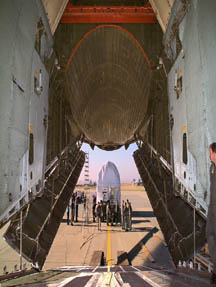 The STAR TPC is loaded into a C5C plane for its trip to Brookhaven. |
Last month, when the first collisions were recorded at the Relativistic Heavy Ion Collider (RHIC) at Brookhaven National Laboratory, it was only fitting that they were initially detected by STAR -- the Solenoidal Tracker At RHIC. One of the two large particle detector systems that will be used at RHIC, STAR is a 60 million dollar, one thousand ton behemoth that is unprecedented in its capabilities. That this huge and complex project, which would eventually involve participants from more than 40 different institutions, was completed on-time and on-budget is a tribute to members of Berkeley Lab's Engineering Division (ED) who played critical roles in STAR's design and construction.
"The main reason we succeeded is that we assembled a good, experienced team that included engineers, designers, technicians, and scientists," says ED deputy division director Bill Edwards, who was the first engineer to be involved with the STAR project, and who would eventually become the project's deputy director. Jay Marx, a physicist with the Nuclear Science Division (NSD), was the project director for STAR.
"In addition to a strong team, we also set realistic expectations," Edwards says. "There is no time to face reality like the present, and one of the first things we had to do was to scope the project to keep it in line with its predetermined budget."
When Edwards joined the project at its outset in 1991, the budget had already been set for $31 million (in FY91 dollars). Working up a rough cost estimate, however, Edwards projected that the costs for meeting the original scope proposed for STAR would be closer to $70 million. After convincing other collaboration leaders that his cost projections were realistic, Edwards worked with NSD physicists John Harris (now at Yale) and Art Poskanzer, among others, to determine what could be designed and built within budget that would still meet the scientists' basic experimental needs.
"The key was to design a detector that could easily be upgraded," Edwards says. "Although we initially descoped the project, we designed the system with upgrade hooks. When DOE opened up a new pot of money for additional experimental equipment even before STAR construction was complete, we were in position to make the best use of it."
In addition to management and systems integration for STAR, ED's other major responsibility in the construction phase was for the detector system's centerpiece, a Time Projection Chamber (TPC). Shaped like a 4 by 4 meter barrel with a volume of more than 50 cubic meters (678 cubic feet), and weighing about 8 tons without electronics, the STAR TPC can detect and sift through thousands of particles at once, a capability critical to STAR's primary mission -- to search for the formation of a quark-gluon plasma (QGP).
Says ED's Russ Wells, who was co-subsystem manager of the STAR TPC along with NSD's Howard Wieman, "This is a fourth generation TPC. The design is in many ways an evolution of previous designs; however, aside from being larger than any of its predecessors, it also broke new ground."
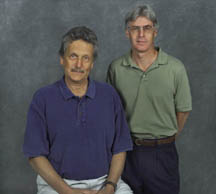 If you need to safely send an object the size of a large room but as fragile as an egg across the country, call Engineering Division's Gary Koehler and Russ Wells. |
Journey across a continent
Construction of the $15 million STAR TPC involved more than 20 ED engineers and technicians and included, in addition to the chamber itself, front end electronics, a gas mixing system, and a water cooling system. Perhaps one of the greatest challenges facing the STAR TPC team, Wells says, came after the detector had been built and successfully tested, when it then had to be transported to the RHIC facility at Brookhaven on New York's Long Island.
"This is not so much a technical problem, although there certainly were many technical issues that had to be addressed, but more of a logistical nightmare," Wells says. "Moving an object the size of a large room but with the fragility of an egg across the country without damaging it required careful planning, diplomacy, engineering and luck."
Ideally, the STAR TPC should be flown across the country, but this required an aircraft with sufficient "headroom." Through the efforts of ED's Gary Koehler, a specially modified U.S. Air Force C5C, one of only two such planes in the world, was found that could do the job.
"The rest of the solution required many conversations to find out how to arrange for the trip, how to get it approved, where we could land, how we could secure the load, what were the temperature, pressure and accelerations ranges, and a host of other issues," Wells says.
After landing, Wells and Koehler had to get approval to shut down the Long Island Expressway to drive the STAR TPC up and over it. Freeway overpasses throughout the island were too low to use alternative routes via side-roads.
Says Wells, "We did not get the permission for the trip across Long Island until the day before the trip and then only because Satoshi Ozaki (BNL's associate lab director for RHIC) personally intervened with the local authorities."
Another major challenge, once the TPC and other components of STAR were completed and in place, was what to do with all the cables, water and gas lines.
"STAR is wired with miles and miles of cable," says Edwards, "and if you don't think about how to handle it and design solutions in advance, you're left with a rat's nest that no one can get around."
After commuting back and forth between Berkeley and Brook-haven on a regular basis between 1992 and 1998, Edwards lived on Long Island for the last 18 months of STAR's construction. Looking back on what it was like to manage and coordinate the efforts of so many individuals from so many different institutions, Edwards says that the essential ingredient for success was trust.
"What makes a multi-institutional construction project so different and difficult is that none of the standard forms of power and authority work very well. To be successful, you have to win the trust of everyone else that you know what you're doing and that you've got the best interests of everyone in mind."
In addition to Edwards and Wells, other engineering leaders on the STAR project were ED's Richard Jared, who served as chief electronics engineer for the overall STAR system, and Fred Bieser of NSD, who served as co-subsystem manager of the STAR TPC electronics effort.
Cool Blue Light: The Making of Blue LEDs
By Paul Preuss
Tiny, sturdy, and far more energy-efficient than incandescent lamps, light-emitting diodes (LEDs) are already widely used in traffic stoplights, vehicle brake lights, and big animated signs. Other uses, including cool, economical home and commercial lighting, are on the way. It's a big business that's getting bigger all the time.
Until the 1990s, LEDs were limited to longer wavelengths, from the far infrared through red to green. Then scientists at Meijo University and Nichia Chemical Industries in Japan found a way to use thin films of gallium nitride and related materials on a substrate of sapphire to produce blue light.
Brighter greens, blues, violets, and even ultraviolet light were soon shining from LEDs made with such materials. Their design and manufacture, however, posed persistent problems. Fundamental scientific questions had not been answered.
Joel Ager, Eugene Haller, Wei Shan, and Wladek Walukiewicz of Berkeley Lab's Materials Sciences Division (MSD), working with colleagues at Hewlett-Packard (now Agilent Technologies) and Xerox, have overcome two important barriers to the economical manufacture of these new solid-state light sources. In separate investigations, they have learned what causes destructive cracking in an essential component of the diodes, and how devices made with gallium nitride alloys can emit light efficiently despite being plagued by numerous structural defects.
How LEDs do it
Near room temperature, the valence electrons of a pure semiconductor such as gallium nitride are locked up in chemical bonds: the valence band is filled with electrons, and the conduction band is practically empty. Because there is an energy gap between these bands (the amount of energy, characteristic of each different material, needed to kick an electron out of the valence band up into the conduction band), there are no mobile charges, and the material is insulating.
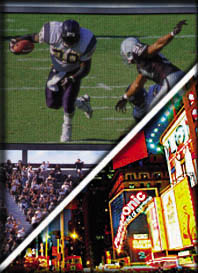
Animated signs such as those in sport arenas and advertising displays. |
In a diode, when electrons from the n-type region "recombine" with holes in the p-type region (or vice versa) they release energy, which takes the form of heat in some materials and light in LEDs. The wavelength of the light is determined by the band gap of the emitting material.
"The conditions for radiative recombination -- emitting light -- are, first, a direct bandgap, so the electrons and holes recombine efficiently; second, a material that is low in defects, preferably defect-free, so the recombination energy is not dissipated as heat; and finally, a supply of holes and electrons injectable from p and n regions," says Eugene Haller.
The hows and whys of indium gallium nitride
In the 1950s it was discovered that all the direct bandgap semiconductors combine one or more elements from group III of the periodic table, such as gallium, with one or more from group V, such as arsenic. LEDs made from gallium arsenide and its alloys became available in the 1960s, but the direct bandgaps of conventional group III-V semiconductors covered only the spectral range from red to amber, leaving much of the visible spectrum beyond the reach of LEDs.
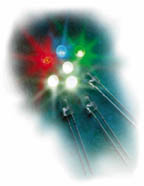
|
Daunting problems remained. The gallium nitride compound itself emits pure ultraviolet light; to get violets, greens, and blues, it has to be alloyed with indium nitride in the right proportions, to reduce the band gap. Because the various alloys each have slightly different lattice parameters, strain results when multilayered structures are grown, and defects form.
"What kills light emission is when electrons or holes are trapped, as in defects, and lose energy to nonradiative processes -- to heat," says Wladek Walukiewicz. Generating light is a constant competition between radiative recombination, an intrinsic property of the material, and the nonradiative processes imposed by different kinds of defects and their concentrations. "The prescription for efficient light emitters is to help the radiative side of the competition by eliminating or at least reducing the concentration of defects," Walukiewicz says.
"There are a huge number of defects in gallium nitride compounds -- a hundred million to 10 billion per square centimeter," says Haller. "If gallium arsenide crystals had as many defects as gallium nitride compounds, no photons could escape. The LEDs would remain completely dark! People were asking themselves how diodes made with gallium nitride alloys, with so many defects, could even work."
In fact, indium gallium nitride devices can emit colors all the way from visible red to ultraviolet, which has made these compounds very attractive. But different groups attempting to make the same material got widely varying results: different colors of light, different efficiencies, different temperature stabilities, and so on.
To resolve these puzzling results, the MSD team studied light emission from small samples of different alloys in a diamond anvil cell, systematically squeezing them to pressures like those deep within the Earth, at temperatures down to four degrees above absolute zero.
"We didn't make diodes, we just illuminated indium gallium nitride samples, the essential part of the diodes, with a laser and studied what kind of light we got out," says Walukiewicz. "This allowed us to plot variations in the energy gap of the materials as a function of pressure and temperature and to elaborate on the nature of the electronic states participating in the light emission."
The results were intriguing. The team found that indium mixes unevenly with gallium nitride, and in very small areas where indium is concentrated, the band gap is less than the average for the material as a whole. In these small regions, light-emission intensity is higher. Because they are small, numerous, and distributed throughout the material, indium-rich regions produce light efficiently even though the crystal is riddled with defects.
Haller says, "Through these studies we were able to gain a significant understanding of how the bandgap is modulated through compositional variations in these materials."
Preventing cracks
A different problem in the manufacture of LEDs made with gallium nitride is that large cracks develop in gallium nitride films doped with silicon, which is used for the n-type base structure of the devices.
"Gallium nitride films are vapor-deposited on sapphire at a temperature of 1,000 degrees Celsius," explains MSD's Joel Ager. Sapphire, crystalline aluminum oxide, "is a good substrate because it can take the high temperature, but its lattice constant and thermal-expansion coefficient are not well matched to gallium nitride." This results in stress.
Even so, gallium nitride not doped with silicon resists cracking. Indeed, Walukiewicz points out that "gallium nitride is very strong, very mechanically stable, and has a large heat capacity. You can run it red hot."
Adding silicon makes a drastic difference. "You need a fairly thick n-type layer at the bottom of the stack in a multilayer device," says Ager, "but at high thickness and high silicon concentration, the gallium nitride layer shatters like ice."
Yet silicon atoms themselves do not appreciably distort the crystal structure of gallium nitride or change its response to heat. What difference could doping with silicon -- typically only one part in a thousand -- make?
The team made a systematic study of stress in films, grown by Hewlett-Packard and Xerox, with a wide range of thicknesses and silicon concentrations. Stress was measured by several complementary methods: optical studies at Berkeley Lab, electron microscopy at Xerox, and x-ray diffraction at both Hewlett-Packard and Xerox. Eventually a consistent picture emerged.
"It turns out that silicon changes the growth mechanism," says Ager. "In gallium nitride doped with silicon, as the layer grows, it creates tensile stress," which pulls flaws open. "The thicker the layer grows, the greater the stress. Eventually a flaw of sufficient size will cause a crack to develop, and the layer will rip itself apart."
Growth by vapor deposition is always at the surface of the material, and silicon changes the way gallium and nitrogen react on the surface. With this information, Hewlett-Packard was able to change growth conditions to produce large gallium nitride devices more economically.
"By cooperative work between Berkeley Lab, HP, and Xerox, we untangled a very subtle but important problem," says Ager. "It's a pleasure to have access to real problems in industry that will have a substantial impact on our way of life."
For more about the results of the three-year cooperative research and development project between Berkeley Lab and Hewlett-Packard, now Agilent Technologies, see http://www.lbl.gov/msd/PIs/Haller/99/99_11_HP.html and references therein.
Great Kick-Off for Summer Lecture Series 2000
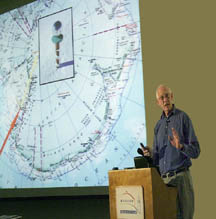
|
Berkeley Lab's 2000 Summer Lectures Series got off to a great start on July 5 with a standing-room-only presentation on DNA replication by biophysicist Carlos Bustamante (left). The lecture covered his current research, including the first direct observations of what happens when the message of a gene is being read during the actual transcription of a single DNA molecule. Bustamante heads the Advanced Microscopies Department for the Physical Biosciences Division.
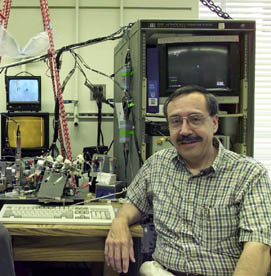
|
The AMANDA collaboration brings together 110 scientists from four countries. Another detector, IceCube, is expected to join AMANDA at the Pole in the near future. "I'm optimistic we will see the universe in neutrino light," Stokstad concluded.
Coming Up in the Lecture Series
The next two installments in the series will continue on the following two Wednesday, July 19 and July 26, with presentations by Mary Helen Barcellos-Hoff and Carolyn Bertozzi.
The one-hour lectures are held at noon in the Bldg. 50 auditorium and are geared to a general audience. Everyone is invited to attend. Bring your lunch and come early to find a good seat.
• July 19 -- Mary Helen Barcellos-Hoff of the Life Sciences Division will discuss "How Tissues Respond to Damage at the Cellular level: The Radiation Effects on Cell Communication." Studies conducted by Barcellos-Hoff and her group point to a coordinated tissue response to radiation that involves factors both inside and outside the cell. Understanding these processes may lead to therapuetic applications.
Multicellular organisms function as the result of the cooperation of many cell types. This lecture will explore what happens to this cooperation and tissue response when individual cells are damaged by radiation.
• July 26 -- Carolyn Bertozzi will talk about "The Chemistry of Cell Surfaces." A MacArthur Fellow and member of the Materials Sciences and Physical Bioscience Divisions, Bertozzi will focus on her work on biomimesis and the engineering of cell surfaces. She and her colleagues have found a way to use natural biological processes to plant artificial markers on the surfaces of living cells and use these techniques to turn cancer cells into targets for diagnostic probes and cell-killing toxins, among other applications.
The Summer Lecture Series is sponsored by the Public Information Department.
Lab Scientists Win Tech-Transfer Awards
William T. Chu of Life Sciences and Ashok Gadgil of the Environmental Energy Technologies Division are the recipients of the Federal Laboratory Consortium Award for Excellence in Technology Transfer.
Chu was honored for his application of proton therapy to cancer treatment with his development of accelerator-based particle therapy and the promotion of its use in hospital-based medical accelerators. Interest in proton therapy and its commercialization is now burgeoning around the world.
Gadgil's award recognizes his development of the much-acclaimed UV WaterWorks, which bring desperately-needed clean water to populations around the world. The device makes decontamination of polluted water possible in a low-cost and energy efficient way using ultraviolet light from a single 40-watt bulb. UV Waterworks is being licensed to two companies -- WaterHealth International of Napa and Urminus Industries in India.
The FLC Awards, established in 1984, recognize individuals within federal laboratories who have done outstanding work in transferring technology to the marketplace.
Berkeley Lab Currents
Published twice a month by the Public Information Department for the employees and retirees of Ernest Orlando Lawrence Berkeley National Laboratory. Ron Kolb, PID department head.
EDITOR: Monica Friedlander, (510) 495-2248, msfriedlander@lbl.gov
STAFF WRITERS: Paul Preuss, (510) 486-6249; Lynn Yarris, (510) 486-5375
CONTRIBUTING WRITERS: Jon Bashor, X5849; Allan Chen, X4210, Jeffery Kahn, X4019
FLEA MARKET / CALENDAR: 486-5771
fleamarket@lbl.gov /
currents_calendar@lbl.gov
Public Information Department, Berkeley Lab, MS 65A
One Cyclotron Road,
Berkeley CA 94720
Tel: 510/486-5771 Fax: 510/486-6641
Berkeley Lab is managed by the University of California for the U.S. Department of Energy.
Washington Report
Carbon dioxide fuel emissions up
DOE's Energy Information Administration has released "preliminary estimates" that show U.S. carbon dioxide emissions from the burning of fossil fuels rose about 1 percent in 1999. Data show emissions climbing from 1,495 million metric tons of carbon in 1998 to 1,511 in 1999. While the 1999 growth rate was slightly below the average annual growth rate of 1.2 percent observed from 1990 to 1999, it was higher than the 1998 growth rate of 0.1 percent.
According to EIA, carbon dioxide emissions account for more than 80 percent of U.S. greenhouse gas emissions and "are a good early indicator of the level of, and rate of change in, total U.S. greenhouse gas emissions."
The preliminary estimates are available at http://www.eia.gov.
Bigger biology books don't measure up
According to the latest study by Project 2061, sponsored by the American Academy for the Advancement of Science, today's high school biology textbooks may be bigger than ever but their content "fails to make important biology ideas comprehensible and meaningful" to students. Instead of content coverage, too many biology textbooks are focusing on "splashy graphics and vocabulary lists."
In the evaluation of 10 widely used and newly developed biology textbooks, none was given high ratings. Said Project 2061 director George Nelson, "Although the textbooks are filled with pages of vocabulary and unnecessary detail, they provide only fragmentary treatment of some fundamentally important concepts."
This is the latest in a series of evaluations by Project 2061 of science and math textbooks. Later this year the project will host a conference on improving K-12 science and math textbooks. More information is available on the web at www.project2061.org/.
NIH called upon to boost instrumentation contributions
The Federation of the American Societies for Experimental Biology (FASEB), the largest professional body representing U.S. researchers in the life sciences, is urging the NIH to nearly quadruple its contribution to a program that helps investigators pay for equipment costing over $100,000.
A recent FASEB survey found that about three-quarters of the 508 NIH-supported scientists who replied felt that the Shared Instrumentation Grants (SIG) program is inadequately funded and managed. Almost half of them said this lack of financial support means that their laboratories are unable to add research technologies as fast as they would like.
Although NIH's overall budget has risen by 15 percent in each of the last two years, FASEB points out that money for equipment has not kept pace. In particular, the SIG program, which allows researchers already supported by NIH grants to split the cost of equipment costing over $100,000, has fallen in real terms over the past decade. FASEB recommends that the program receive $150 million in the financial year 2001.--Lynn Yarris
Los Alamos Director Thanks Berkeley Lab Employees
Following New Mexico's devastating Cerro Grande fires which consumed hundreds of homes in Los Alamos, employees at Berkeley and other national labs sent in contributions to help the victims of the disaster. Last week Currents received the following letter from Director John C. Browne of Los Alamos National Laboratory, thanking the employees of Berkeley Lab for their generosity.
On behalf of the University of California and everyone at Los Alamos National Laboratory, I would like to thank the staff of E. O. Lawrence Berkeley National Laboratory for the support and assistance given to us during the Cerro Grande Fire. Although this was a devastating experience for us, it showed how communities, individuals, and organizations can come together to help each other in a time of crisis. We were overwhelmed by the outpouring of aid and support from throughout New Mexico and the across the nation.
Your help at this very difficult time was greatly appreciated, and will be remembered as we begin the process of recovery and renewal.
Sincerely,
John C. Browne
Director
Director Shank Takes Action to Increase Lab Diversity
Emphasis on divisional outreach, recruitment, education, line management
By Ron KolbBerkeley Lab Director Charles Shank has asked his division directors to develop diversity plans in order to enhance the work environment for all employees and assure that hiring pools are as diverse as possible.
This new effort is part of Shank's renewed commitment to improve the workforce environment at the Laboratory and to make its demographic profile more closely aligned with that of society as a whole.
"We've reached a compliance level, not a leadership level," he said at his June 27 State of the Laboratory address. "This is a public institution, and we should be leaders in this area."
The Director will review each divisional plan personally. He offered the tools and assistance of the Workforce Diversity Office to division directors in his memo to them on June 23. A summary of each plan is due by Sept. 1.
"An expectation relating to diversity performance will be added to the division director job descriptions," he wrote.
Line managers are responsible for assuring that diversity awareness is integrated into divisional activities and decision-making, and for communicating the importance and value of diversity, the guidelines state.
Among the targets suggested for inclusion in the plans are:
- coupling of outreach and recruitment efforts
- education and sensitizing of employees to diversity values
- integration of diversity topics into operations and activities
- minority representation in divisions based upon the Laboratory's overall
affirmative action program
- links with minority institutions and professional organizations, and
- training and education programs to develop future recruiting pools.
In his letter to the Laboratory in Currents on April 7, the Director reiterated the Laboratory's commitment to its people -- "building a community in which diversity is valued, cultural differences are celebrated, and individuals perceive fairness and equity across the board."
Over the last eight years, he noted, minority representation in the workforce has not budged from a level of about 26 percent, and female representation has stagnated at around 31 percent. "I believe we can do much better," he wrote.
"Our goal should be to set an example for the rest of society."
From Fisheries to the Farthest Reaches of Space
By Paul Preuss
Jeff Beeman looked up at a lot of starry skies while he was tending fisheries resources in upstate New York for the Department of Environmental Conservation. But at the time it never occurred to him that he would one day be sending instruments into the upper atmosphere, and even into space, to measure faint signals from the farthest reaches of the cosmos.
When Beeman's wife, a geophysicist, was offered a job in the Bay Area in 1984, he decided to facilitate her career by changing his own -- to what, he wasn't sure at first. But when Eugene Haller of Berkeley Lab's Materials Sciences Division hired him as a research technician, he found a new calling.
One of Haller's interests was creating radiation sensors based on semiconductors, and Beeman became involved in the quest to build a better bolometer. A bolometer is a sensitive device for measuring small amounts of heat -- for example, determining the tiny variations (on the order of a hundred-millionth of a degree) in the temperature of the cosmic microwave background radiation, which averages less than three degrees above absolute zero.
Beeman found the challenge so engaging that he was soon taking courses in materials science and electronics at UC Berkeley. "My heart is still in fish and wildlife," he admits, "but my brain is fascinated by materials science."
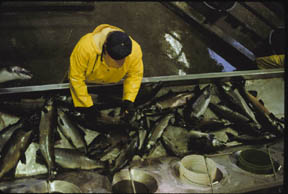
|
"For normal semiconductor applications you can add dopants in the crystal melt or in other ways," says Beeman, "but small fluctuations in dopant concentration can lead to huge fluctuations in resistivity. For cryogenic thermistors you need a way to distribute the dopant atoms randomly throughout the crystal."
Enter germanium, a semiconductor material with an extraordinary property. When atoms of some isotopes of germanium absorb low-energy neutrons, they transmute into dopant atoms. For example, when a germanium 74 atom captures a neutron, it transmutes into an arsenic 75 atom, a dopant that adds electrons; when germanium 70 captures a neutron, it transmutes into gallium 71, a dopant that adds holes.
"Eugene had been working with germanium for years, and when he learned that germanium could be doped via neutron transmutation, it sparked his imagination," Beeman says. He explains that "95 percent of thermal neutrons will fly right through a three-millimeter-thick germanium crystal, but the others will be captured by atoms distributed absolutely randomly throughout. If neutrons could be used to heavily dope germanium, that would be the way to go."
Haller, Beeman and their colleagues tested numerous samples of germanium, some of them isotopically enriched. Using research nuclear reactors to supply the neutrons, they were soon ready to turn out thermistors tuned precisely to the needs of different experimenters.
Flying high
Over the years, detectors based on neutron-transmutation-doped (NTD) germanium have become increasingly sophisticated and their uses increasingly versatile. The recent astrophysical spectaculars BOOMERANG and MAXIMA, balloon-borne mapping expeditions of the cosmic microwave background sky, both used bolometers with NTD germanium thermistors at their hearts.
Beeman worked with James Bock, formerly a graduate student at UC Berkeley and now with NASA's Jet Propulsion Laboratory, in fabricating the bolometers used in BOOMERANG and MAXIMA. Besides the thermistor, the other crucial part of the bolometer is the absorber, the antenna-like structure that detects infrared radiation. Because energy deposited by cosmic-ray particles poses a major problem in balloon-borne experiments, Bock devised a "spider web" absorber of etched silicon-nitride fibers only a few micrometers in width. Millimeter-wavelength radiation from the cosmic microwave background is caught in the mesh, but cosmic ray particles pass right through it.
"Jamie needed a much less massive thermistor for his spider web," says Beeman, "and he approached us at exactly the right time." Beeman had recently been working on low heat-capacity "flat pack" thermistors for use as x-ray spectrometers, and had already developed devices with dimensions as small as 300 by 100 by 25 micrometers (millionths of a meter).
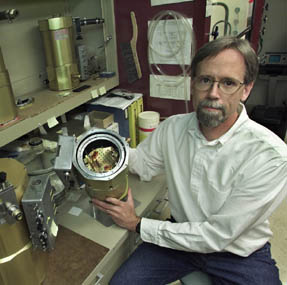 Jeff Beeman (above) switched careers from wildlife (above) to outer space. He and JPL's Jamie Bock fabricated the bolometers. |
The fabrication of the bolometers involved much back-and-forth between Berkeley Lab and JPL. Beeman cut and thinned the NTD germanium crystal, Bock applied a photolithographic mask to the wafer, Beeman performed an ion-implantation step, and Bock added indium bumps -- "not solder, just soft, sticky metal that would attach the thermistor to the web by pressing it, like putty." Finally, Beeman cut out the finished devices with a diamond saw and etched their edges clean.
The result was a bolometer designed to operate at three tenths of a degree above absolute zero, yielding data for the finest-resolution maps of the cosmic microwave background yet made.
Heat sensitive
The cosmic microwave background is only one form of radiation for which NTD germanium is an excellent detector. Haller and Beeman's NTD germanium thermistors will be used in an intriguing ground-based neutrino-physics experiment deep beneath a mountain in Italy -- the Cryogenic Underground Observatory for Rare Events (CUORE) at Gran Sasso -- which will search for never-before-seen double-beta (two-electron) radioactive decay events to detect the slight temperature rise associated with reabsorption of the electrons released in the decay.
"If you get NTD germanium cool enough, you can detect events of extremely low energy, even a single x-ray hit," Beeman says.
Beeman and his colleagues are now competing to provide the calorimeters for NASA's ambitious Constellation-X mission, an array of orbiting x-ray telescopes intended to fly within the next five years.
Through JPL's Bock, they have already been chosen to supply spider-web-mounted thermistors for an imaging instrument aboard the European Space Agency's Far Infrared and Submillimeter Telescope (FIRST) satellite and for a spectrometer on board ESA's PLANCK mission, a cosmic-microwave background satellite.
"We're pushing detection to finer and finer scales," says Beeman. "The cosmologists love the results."
From the lab right into space, miniaturized devices based on the neutron transmutation doping of germanium have allowed the measurement of faint signals that would have been thought impossible to detect little more than a decade ago. Although it required a long journey from the woods and streams of upstate New York, Jeff Beeman has contributed greatly to that scientific advance.
Bulletin Board
Intern Picnic
For the seventh time Berkeley Lab will be hosting a summer student picnic on Friday, July 21 from 12 to 1 p.m. on the patio area between Bldg. 2 and Bldg. 6 (the ALS). Hundreds of interns, mentors and other Lab employees have gathered in past years for this student celebration. Barbecued food and musical entertainment will be provided.
The event recognizes the efforts of all those who are contributing to the Lab's summer intern programs, which are coordinated by the Center for Science and Engineering Education.
The picnic is funded by the Employees' Activities Association with assistance from the Latino and Native-American Association (LANA), the Gay, Lesbian, Bisexual, Transsexual and Friends (GLBTF) Association, and the African American Employee Association (AAEA).
Stress Management Group Meetings
The Stress Management group kicked off its biweekly meetings yesterday and will meet on the second and fourth Thursday of each month at noon in Bldg. 70, Room 191. Advanced registration is advised. Contact Paul Molinari at X4953, P_Molinari@lbl.gov
Mac Users Group Events
The Macintosh Users Group (LBNL MUG) will host a number of major events over the next few months. On Aug. 9, an Apple representative will be onsite to show off OS X beta. On Sept. 13, someone from the Computing Infrastructure Support Department will talk about the ins and outs of constructing your own Ethernet network. And on Oct. 11, a MicroMat representative will talk about TechTools 3.0.
The meetings will be held in Bldg. 90-3148 starting at 11 a.m.
Hall of Science Seeks Volunteer Docents
UC Berkeley's Lawrence Hall of Science is looking for volunteers who wish to learn more about science and science education and help children and families enjoy science. A science background is not needed -- only a desire to learn and serve.
Volunteers for the Docents Program may select their assignments. Opportunities include:
- special events and science demonstrations
- exhibit tours
- Computer Lab programs
- the Resource Room
- school programs and after school classes
- summer camps for children
- the Discovery Corner gift store
- lab and equipment maintenance
For more information or to request an application form, contact the Docent Coordinator, Lawrence Hall of Science, University of California, Berkeley, California, 94720, 643-5471.
Be a Life Saver -- Summer Blood Drive
The next onsite blood drive, part of an ongoing partnership between Berkeley Lab and the American Red Cross Blood Services, is scheduled for Tuesday, July 25 (7 a.m. to 1 p.m.) and Wednesday, July 26 (8 a.m. to 1 p.m.). Both session will be held in Bldg. 70A-3377.
Donors are encouraged to sign up online at the BeADonor website (www.beadonor.com) to help organizers plan the event. Please use company code "LBL" on the web form.
To be eligible, donors must be in good health, at least 17 years old, weigh at least 110 pounds, and have not donated blood in the last 56 days. Detailed donor eligibility requirements can be found on the BeADonor website.
For additional information about the blood drive contact Charlotte Bochra at X4268. All participants in the Summer Blood Drive will receive a BeADonor T-shirt.
Benefits Offers Brown Bag Seminar Series
Starting next month, the Benefits Office in conjunction with Fidelity Investments will be offering a series of brown bag seminars on saving, investing and retirement options for Lab employees.
All three session will be held from 12 to 1:30 p.m. in the Bldg. 66 auditorium.
• Aug. 18 -- The first workshop in the series, Getting Started, is intended for employees who are not enrolled in the Workplace Savings Plan in order to help them understand the benefits of participating in this program. The workshops will cover topics such as debt management, investment basics, advantages of tax deferred savings and compounding, and the benefits of starting early.
• Sept. 15 -- Investment Strategies is designed for employees who are currently participating in the Workplace Savings Plan and are more than 10 years away from retirement. The goal of this workshop is to help participants determine whether their asset allocation is in line with their future savings needs.
Participants will be asked to consider whether they are deferring as much as they can, and will be shown the advantages of incremental changes in their deferral rate and asset allocation. The presentation will also describe the importance of reviewing, reevaluating and rebalancing their portfolio management.
• Oct. 27 -- The last seminar will focus on Retirement in View. The session is taylored for pre-retirees who are five years or more away from retirement. The presentation reviews retirement lifestyles and financial considerations. Participants will work through retirement expenses, income sources, and strategies to help close existing gaps.
To reserve space for any of these session call the Fidelity central reservation system at (800) 642-7131.
Fidelity Adds Consultations
Due to the high demand, the Benefits Office has arranged for Fidelity to add additional days for personal consultations, currently being held twice a month. The extra days are Aug. 29, Sept 6, Oct. 31, and Nov. 10. To schedule a consultation call (800) 642-7131.
The sessions are being held in Bldg. 54, Room 2 (lower level).
Cal State 9 Rep Here
The Benefits Office has arranged for Cal State 9, one of the credit unions representing Lab employees, to have a representative onsite twice a month to hand out information and answer questions. No individual appointments are offered.
The representative will be available at the cafeteria entrance from 10 a.m. to 1 p.m. on the following dates: Aug. 4 and 24, Sept. 7 and 21, Oct. 5 and 19, Nov. 2, 16, and 30, and Dec. 14.
Calendar of Events
July 14 - 28, 2000
General Interest Calendar
FRI., JULY 14
FIDELITY RETIREMENT SESSIONSBldg. 54 (cafeteria) lower conf. rm.
WED., JULY 19
SUMMER LECTURES SERIESMary Helen Barcellos-Hoff on radiation effects on cell communication.
12 p.m., Bldg. 50 auditorium
FRI., JULY 21
SUMMER INTERN PICNIC12 p.m., Bldgs. 2 & 6 patio area
TUES., JULY 25
SUMMER BLOOD DRIVE7 a.m. - 1 p.m., Bldg. 70A-3377
WED., JULY 26
SUMMER BLOOD DRIVE8 a.m. - 1 p.m., Bldg. 70A-3377
SUMMER LECTURES SERIES
Carolyn Bertozzi on the chemistry of cell
surfaces.
12 p.m., Bldg. 50 auditorium
THURS., JULY 27
STRESS MANAGEMENT MEETING12 p.m., Bldgs 70-191
FRI., JULY 28
FIDELITY RETIREMENT SESSIONSBldg. 54 (cafeteria) lower conf. rm.
Please e-mail announcements and items for the General Calendar to MSFriedlander@ lbl.gov. You may also fax them to X6641 or mail them to Bldg. 65B. The deadline for the July 28 issue is 5 p.m. Monday, July 24.
Seminars & Lectures
WED., JULY 19
PHYSICS DIVISON RESEARCH PROGRESS MEETING"High Energy Nucleus-Nucleus Collisions and Signatures of Deconfinement" will be presented by Sonja Kabana of the University of Bern, Switzerland
4 p.m., Bldg. 50 auditorium
LIFE SCIENCES INFORMAL POSTDOC SEMINAR
Wen Chen, a postdoctoral
candidate at the California Institute of Technology, will present an informal
seminar on "Extragenic Suppressors of Heat Shock Activated Goa in C.
Elegans."
10 a.m., Bldg. 84-318
Seminar hosted by Paul Yaswen, X4192
FRI., JULY 21
PHYSICS DIVISON RESEARCH PROGRESS MEETING"Bs Mixing at SLD" will be presented by Stephane Willocq of the University of Massachusetts.
2 p.m., Bldg. 50A-5132
MON., JULY 31
ACCELERATOR & FUSION RESEARCH DIVISION COLLOQUIUM"Chaos in Washington: What Else is New for FY 2001?" will be presented by Michael Lubell of the American Physical Society and CCNY.
Noon, Bldg. 50 auditorium
Graduate Students, Postdocs Invited to NERSC Workshop on High Performance Computing Tools
NERSC is now taking applications from graduate students and postdoctoral fellows to participate in a three-day workshop on the ACTS Toolkit, to be held at Berkeley Lab on Sept. 28-30.
DOE will fully sponsor students and qualified postdoctoral fellows, covering the cost of transportation, lodging, meals and workshop materials. The deadline for applications is Tuesday, Aug. 1.
The ACTS (Advanced Computational Testing and Simulation) Toolkit is a set of DOE-developed software tools that make it easier for programmers to write high-performance scientific applications for parallel computers.
The aim of the workshop is to familiarize students in various scientific disciplines with computational science tools that can help them in their research. The tools in the ACTS Toolkit provide solutions for numerical problems, scientific data representations, data manipulation, visualization, program execution and distributed computing. More information is available on the ACTS website at http://acts.nersc.gov.
The ACTS Toolkit differs from other "parallel tools" projects in that it primarily focuses on software used inside an application, instead of software used to develop an application. The tools were mostly developed at DOE labs and universities.
ACTS is an umbrella project that has brought the tools together and is funding development efforts. While DOE has developed the tools for its own programs, it also encourages their adoption and use by other programs.
Application procedure
Graduate students and post-docs from any scientific field who are interested in attending the workshop must submit a short abstract describing their work and current or future computational needs. Abstracts should be sent to acts-workshop@ nersc.gov.
Students must also provide a letter of recommendation from their advisor (sent to the same e-mail address and with the student's name in the subject line) by Aug. 1. Other applicants must submit a letter outlining their current work and future plans and needs for computational resources with a list of publications.
More information on the workshop is available online at http://acts.nersc.gov/wrkshop. You may also contact Tony Drummond at X7624 or Osni Marques at X5290.--Jon Bashor
ACTS Toolkit Workshop
Sept. 28-30 -- Berkeley Lab
Application deadline:
Aug. 1
Softball Club
Ballpark Est. - Camshafts (13-3)
Environmets - Pedal Pushers (14-7)
Collisions - PCT (24-6)
Animals - Rated X (6-10)
SUDZ - Hard Drives (29-1)
Las Chupacabras - Drosoftballa (1-1)
Standings after seven weeks of play (ties listed by alphabetical order):
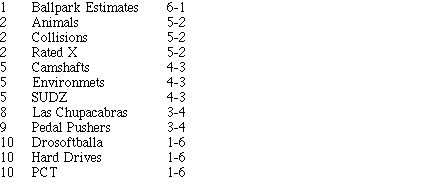
FleaMarket
Autos / Supplies
'99 HONDA SUV, less than 10K mi, black, mint cond, V6 3.8L, ac, pwr steer/wind/door, stereo/cass, cruise, dual airbags, $23,000/bo, Tamra, X4530`94 PLYMOUTH VOYAGER, white, 102K mi, radio/cass, new tires & breaks, moving overseas, good cond, clean, $4,000 $/bo, Gilles or Benedicte, X4444, (925) 671-7209
`93 NISSAN-MAXIMA GXE, auto, ac, cruise, Sony 10 disc CD changer truck mount, burgundy color, 96K mi, asking $7,500, Eva, X6952, (925) 778-6077 (eve)
`92 TOYOTA Tercel, 2 dr sedan, 105K mi, good cond, moving sale, $2,600/bo, X2370
'91 NISSAN SENTRA, 2 dr sedan, manual, 93K mi, ac, stereo/cass, pwr steer/brakes, cruise, very reliable, runs exc, $3,490/bo, Werner, X2901, 525-1090
'90 Subaru Legacy, light blue, 4 dr sedan, 150K mi, auto trans, radio/ cass, cruise, pwr win/steer, sunroof, good cond, great commute car (30+ MPG highway), maint & service records avail, $3,200/bo, Tom or Shelly, 477-9342
'88 FORD ESCORT, 103 K mi, 4 dr, auto, stereo, rebuilt transm, new front brakes, new tires, runs great, $1,600, 526-5495 (eve)
`88 FORD RANGER LXT 4X4, 2.9L/6 cyl, ext cab w/campershell, new tires, battery, brakes, clutch, pwr breaks/seat, stereo/CD, 117K mi, $2,200/bo, Bill, X7726, 223-4457 (eve)
'87 OLDSMOBILE CUTLASS CIERA, exc cond, new tires & transmission, runs great, $2,000, Simona, X4417, 845-3327
'84 CHRYSLER STATION WAGON, 130K mi, new Michelins, tinted windows, old but reliable, cheap, $500, fred, X6964, (925) 937-3165
Motorcylcles
`81 KAWASAKI CSR 650, 49K mi, needs front brake work, $175, Vern, 528-2951Housing
BERKELEY, room for rent in 2-bdrm house, near UC/LBNL, partly furn, washer/dryer, garden, avail 7/1-12/1, or by month, $605 + util, Bryan, bdlocd@dante.lbl. gov, X2266, 845-3248N. BERKELEY, 1+ bdrm/1 bath upper flat, fully furn incl dishes and linens, b&w TV, fireplace, some view, laundry, off-street parking for 1 car,carpet, on #8 bus line, lge master bdrm + 2 very small rooms, near park, non-smoking only, avail 7/21 (8/1 ok), $1,250/mo + util, Rachelle, 548-0431
N. BERKELEY, share 2 bdrm apt near Monterey Market, shops, public park, BART, interest in fitness & music helpful, $450 + util, avail after Aug 1, Harold, 527-3931
UNION CITY, lge 3 bdrm/2 baths furn house, avail for sublet 8/1 -10/15, 10 min walk to BART,quiet family neighborhood, no pets, no-smoking, $1,350/mo incl utilities, Tom or Shelly, 477-9342
Housing Wanted
GOOD-NATURED VEGETARIAN, LBNL employee, seeks room or apt within 10 mi of Lab, quiet, cheerful, don't smoke/drink/drugs, David, 841-0259, X6409GRADUATE STUDENT working on thesis at LBNL, looking for studio or 1 bdrm apt, second week in Aug through secod week of Dec, pref furn, X5604
POSTDOCTORAL FELLOW, responsible, quiet female, looking for studio, furn or not, near LBNL, starting date flexible, Rana, rzahedi@lbl.gov, X4368
VISITING JAPANESE RESEAR-CHER, wife & 3-yr-old child seek 11-months rental of 2 bdrm furn apt or house starting Sept 1, non-smokers, walking distance to shops, Philip Haves, X6512, PHaves@lbl.gov, akashi@beel. arch.kyushu-u.ac.jp
VISITING SCIENTIST, wife and 2 daughters (2 & 5) seek one-month rental of 2 bdrm furn apt starting July 19, Remi, X4081, FRCarrie@lbl.gov
Misc Items for Sale
16MB MEMORY CARD for IBM ThinkPad (model KTM-TP360/16), will work in ThinkPad series 355, 360s, 730s, & 755s, will boost 360 from 4MB to 20MB and 755 from 8MB to 24MB, $20, Anton, X2908CD-RW BURNER, ZipCD 650 for Win 98 PC w/USB, $220; Sony bookshelf stereo syst, $120; Fisher scientific monocular microscope 4/10/40, $120; cordless phone, $40; compact CD player, $40; binoculars, $40; guitar stand, $20, Garrett, X2324
EXECUTIVE DESK, 4-drawer, $50; tall bookshelf, $15; fax machine, Panasonic, $25; octagonal coffee table glasstop, $15, (925) 831-9172
FULL SIZE FUTON, green, $115; telephone table, black, $30, 2 director chairs, $15; comb book shelf/liquor cabinet, 4 shelves, wood, $55, coaster 4 tier metal shelf, black, $35; card table, $20; 2 chairs, $20, plants, telephone table (black), $30, wicker baskets ($6 and $20), reading lamp $5, all exc cond, Alfonso, X4332, 558-9246
FUTON, barely used, cherry wood finish, comes with pad and 2 covers, $225/bo, Tamra, X4530
GARAGE SALE, July 15, 9-4, Maxwell Park, Oakland, 3217 Knowland Ave, baby items (crib, cradle, stroller/carseat, clothes, toys, little tykes) women's & men's clothes/shoes, household items, patio furniture, TV, single futon, rocker recliner, more, Norm, X6724
GIRL'S ROOM FURNITURE, Scandin design, white color, bed w/steel frame & mattress, $100; desk, $30; bookshelf, $20; floor lamp, $5; stereo stand, $15; arm chair, $10, picts avail, you pick up, Nanyang, X5814, (650) 926-2252, 799-6617 (eve)
KENMORE WASHER, gas dryer, old but work great, $75 for both; freezer, 12 cu ft upright, $75; stove, gas, slide-in, very clean, avacado green, $25, Ken, X7739, 482-3331
MOVING SALE, July 15, 10 -4, 2129 Roosevelt nr Addison, Berkeley, utensils, furniture, more: bookcase, 30w x 60h; chest w/6 drawers, 48 w oak and pbd computer workstation w/hutch; stereo cabinet, TV stand, hdwood 4-drwr file cabinet, offers entertained beforehand, Stephen, X929, 540.7489
TICKETS, 4 good lower grandstand (3rd base) box seats for Giants vs. Pittsburgh on Aug. 5, face value, $23/ea, John, X5390
VACUUM PUMP, Welch #1405, DuoSeal belt-drive, rated to 0.0001Torr, brand new, never used, cost $1,700, sell for $1,000, info & images at http://home.inreach.com/mrayers/temp/pump.htm, Mike, X4292
WASHER, front-loading, energy-efficient, water-saving, Kenmore, less than 1 yr old, exc cond, white, $400 firm; gas dryer, lge capacity, exc cond, Kenmore, less than 1 yr old, matches washer, $200; full sz futon, good cond, comfortable, hardwood, foam core, tri-fold, cover not incl, $150; Alyssa, 985-1818, X5958.
Wanted
EXPERIENCED MUSICIANS for the WMBK Jazz Quartet (LBNL Music Club) interested in playing jazz Tuesdays and Thursdays at noon; we have some charts, upcoming gigs, mainly looking for horns, jazz guitar, vocalist, currently have piano, bass, drums, flute, for audition call Wesley, X7893TRUCK, any non-1980s, less then $5,000, Duncan, X6597
Vacation
SOUTH LAKE TAHOE, spacious chalet in Tyrol area, close to Heavenly, fully furn, sleeps 8+, sunny deck, pool and spa in Club House, close to casinos and other attractions, $125/night, Angela, X7712, Pat/Maria, 724-9450TAHOE KEYS at S. Lake Tahoe, 3 bdrm house, 2-1/2 bth, fenced yard, quiet, sunny, close to attractions, private dock, great view, $150/night, 2 night min, Bob, (925) 376-2211
Lost & Found
FOUND: Navy blue glasses case, inscription inside reads Sadaf and a phone number that does not work, has 2 yellow pieces of cloth w/pictures of round glasses, Norma, X6151, 50B-4230
Flea Market Policy
Ads are accepted only from LBNL employees, retirees, and onsite DOE personnel. Only items of your own personal property may be offered for sale.Submissions must include name, affiliation, extension, and home phone number. Ads must be submitted in writing: via e-mail (fleamarket@lbl.gov), fax (X6641), or delivered/mailed to Bldg. 65B.
Ads run one week only unless resubmitted in writing, and are repeated only as space permits.
Currents reserves the right to edit ads for space and style. Once submitted for publication, ads may not be retracted for any reason.
The deadline for the July 28 issue is Thursday, July 20.